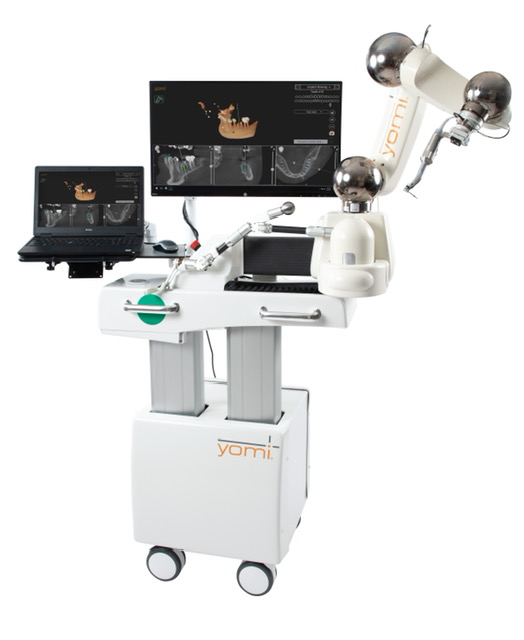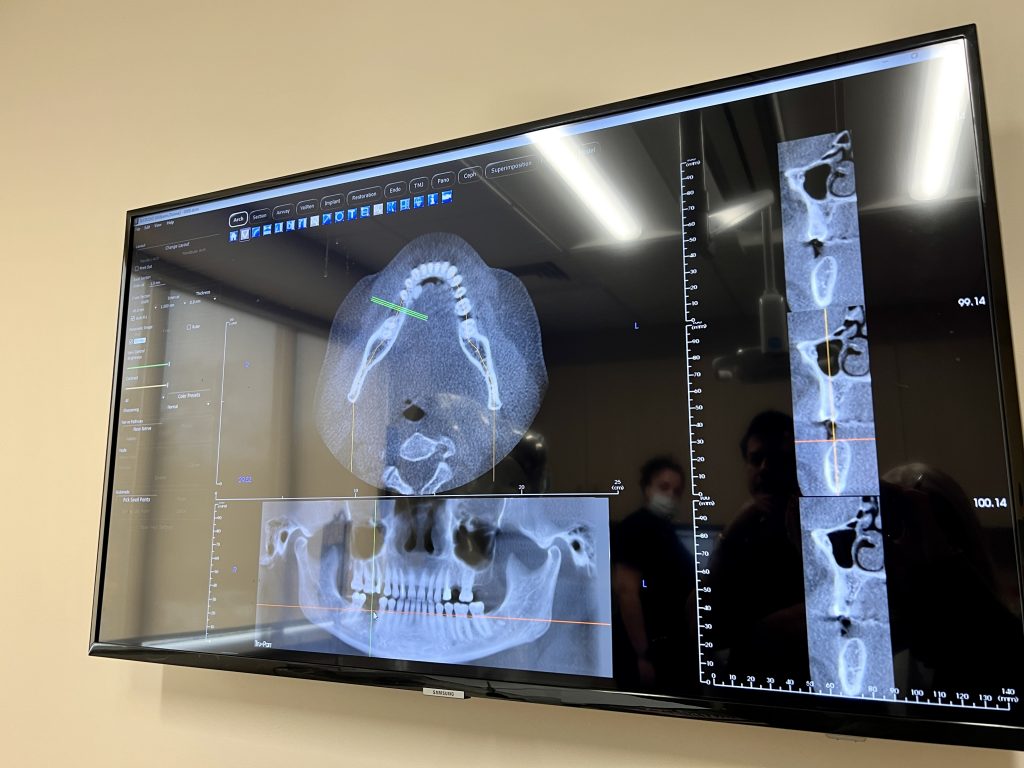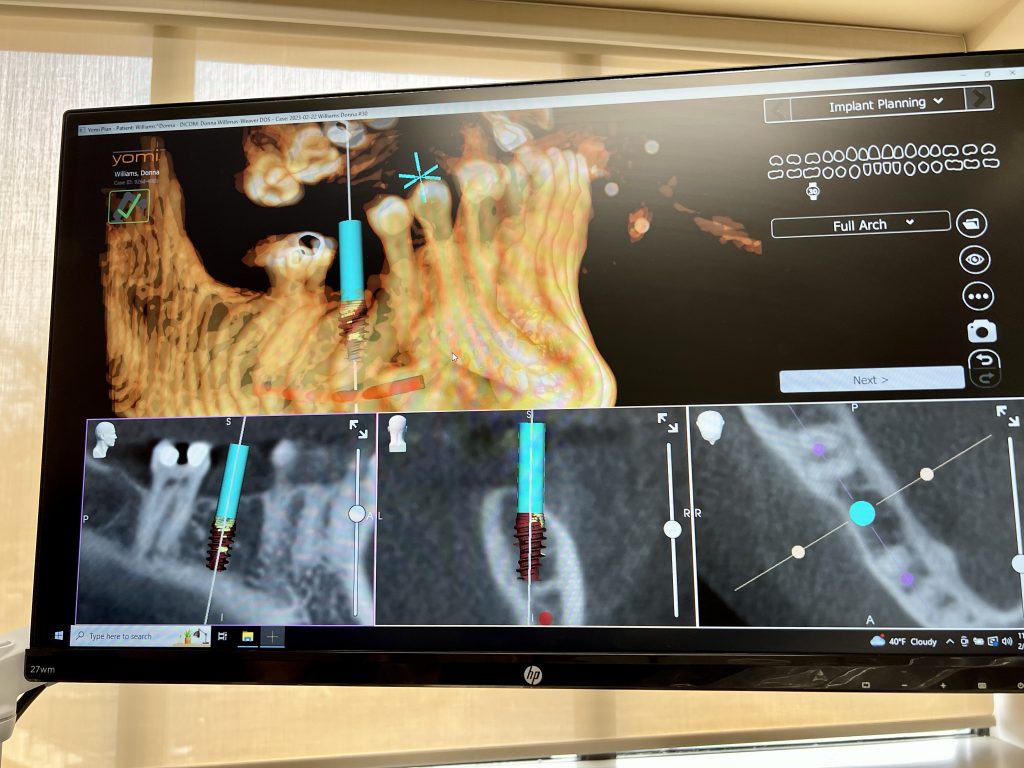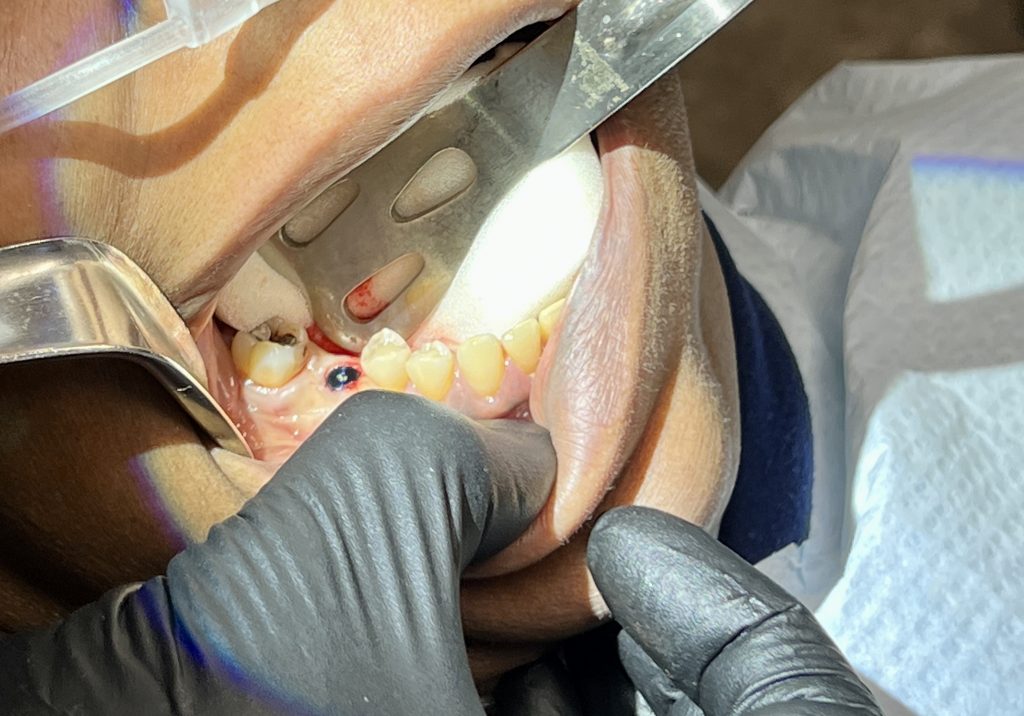West Hartford Oral Surgeon Pioneers Robotics

Audio By Carbonatix

West Hartford oral surgeon Dr. Ryaz Ansari describes the process of placing a dental implant in patient Donna Williams with the use of the Yomi Robotic Dental system. Photo credit: Ronni Newton
Dr. Ryaz Ansari was first in Connecticut to use a robot for dental implants.

West Hartford oral surgeon Dr. Ryaz Ansari finalizes his digital plan before beginning the process of placing a dental implant in patient Donna Williams with the use of the Yomi Robotic Dental system. Photo credit: Ronni Newton
By Ronni Newton
Dr. Ryaz Ansari’s assistant is as steady-handed as they come, and able to place dental implants in the exact right position even if the patient suddenly moves.
That’s because the West Hartford oral surgeon’s assistance is a robot, involved in roughly 80% of the implant procedures he performs.
The Yomi Robotic Dental system, manufactured by Neocis, is the first – and to date still the only – FDA-approved robot in the dental space. And Ansari was the first in Connecticut to pilot its use, and now uses the device in a majority of his cases.

The Yomi Robotic Dental system. Courtesy photo
“I was looking to be on the cutting edge,” he said, “to be on the leading edge of surgical techniques, where you want to be 10 years out.”
Ansari has had the Yomi device – which was approved by the FDA in 2017 – since 2018, and was eighth in the country to begin using it in his practice.
“We found each other,” he said of his relationship with Neocis. He was actually involved with the company as the device was being visualized, and helped develop the workflows. From the onset he thought the Yomi device would revolutionize the dental implant procedure.
“I thought in five years everybody would be using one,” Ansari said. “I’m using it in more and more cases.” Although there are some cases where the traditional “freehand” method of placing a dental implant is more appropriate, such as when the bone must be built up, those represent a small percentage of his patients.

Before beginning a dental implant procedure using the Yomi Robotic Dental system, Dr. Ryaz Ansari and his assistants review images of the patients mouth and create a digital workflow. Photo credit: Ronni Newton
Ansari likens the technology to electric cars – considered a high-tech novelty at first, but eventually becoming more mainstream, although still not the best choice for all situations.
The Yomi Robotic Dental system is now in use by 160 dental practices, up from roughly 20-30 when Ansari got his, and it’s also being used in five dental schools and one hospital.
Ansari said people come to his practice from throughout the region because of the device, which cuts the surgery time from two hours to 15 minutes in most cases. Recovery is much faster as well, because Yomi accomplishes its work in a minimally-invasive manner, without need to open the gum. There is no incision, other than the hole made by the drill which is no larger than the width of the implant that is inserted.
In most cases, the entire procedure can be completed in one office visit.
Planning, which very much requires Ansari’s human touch and skill, is done in advance outside the mouth.
“The reason we use the Yomi is that it allows us to place [the implant] more precisely,” Ansari said. “The implant has to be placed in a precise location,” he said, the perfect depth, angle, and position in the jaw, while avoiding impact on the alveolar nerve and other nerves found in the mouth.
The patient doesn’t have to remain completely still either. The Yomi is able to compensate for movement because it’s able to do computations in milliseconds.

West Hartford oral surgeon Dr. Ryaz Ansari describes the process of placing a dental implant in patient Donna Williams with the use of the Yomi Robotic Dental system. Photo credit: Ronni Newton
“Why the Yomi is such an interesting concept is that you can do [implants] freehand by looking at a 3D scan of the bone, but this brings a robotic guide,” said Michelle Visser, regional manager for Neocis. Of the 34 robotic devices used in the medical field, she said, this is the first in the dental space.

A schematic indicates precisely the location, depth, and angle of the implant’s placement before the procedure begins. Photo credit: Ronni Newton
“What robotics does is plans in real time off your scan on that day. … It’s really the pinnacle of implant placement,” Visser said. “With robotics, you make an entire digital workflow.”
Ansari’s patients are primarily referrals from dentists, and most come to him because of his use of the Yomi Robotic Dental system.
People need implants for a variety of reasons, and Ansari said his average patient is in their 50s or older who have lost a permanent tooth. He also places implants for younger patients who were born without one or more teeth, and those who have had teeth knocked out.
“It’s interdisciplinary work with the dentist,” he said. Replacing a front tooth requires more coordination with the dentist who will be placing the cap over the implant, to ensure the teeth will be perfectly aligned.
New Britain resident Donna Williams, 59, agreed to be photographed while Ansari and the Yomi went to work in Ansari’s office at 928 Farmington Avenue in West Hartford Center. She was mildly sedated by an anesthesiologist so she would be in a “twilight” state for the procedure.
The Yomi, encased in plastic, has a human-like arm – that ends in a drill. It follows a program created by Ansari in advance, guided by a GPS-type system that shows the exact location of the equipment through each step of the process which includes drilling and then screwing the implant into place. It also provides audible feedback. The device locks into position when it gets within 5mm of the surgical site, and at that point Ansari can only move it up and down.

Dr Ryaz Ansari utilizes the Yomi Robotic Dental system, with a variety of drill bits, in a precise process that he planned in advance and that culminates with the proper placement of a dental implant in his patient. Photo credit: Ronni Newton
“We’ve determined the depth, position, and angulation,” Ansari tells Williams as she drifts off. “Now we’ll just do it.”
Fifteen minutes later, the surgery is over, and Williams is in the process of waking up with a new implant placed where she was missing a tooth on her lower jaw. A temporary cap will cover the area until her regular dentist installs a more permanent cap.
“It can only do what I tell it to do,” Ansari said. “It combines the best ability of a human mind and the best ability of a machine.”

Dr Ryaz Ansari utilizes the Yomi Robotic Dental system, with a variety of drill bits, in a precise process that he planned in advance and that culminates with the proper placement of a dental implant in his patient. Photo credit: Ronni Newton

Dr Ryaz Ansari utilizes the Yomi Robotic Dental system, with a variety of drill bits, in a precise process that he planned in advance and that culminates with the proper placement of a dental implant in his patient. Photo credit: Ronni Newton

Dr Ryaz Ansari utilizes the Yomi Robotic Dental system, with a variety of drill bits, in a precise process that he planned in advance and that culminates with the proper placement of a dental implant in his patient. Photo credit: Ronni Newton

A temporary cap will be placed over the implant to protect the area until her dentist installs a permanent cap. Photo credit: Ronni Newton
A version of this article previously appeared in the April issue of West Hartford LIFE.
Like what you see here? Click here to subscribe to We-Ha’s newsletter so you’ll always be in the know about what’s happening in West Hartford! Click the blue button below to become a supporter of We-Ha.com and our efforts to continue producing quality journalism.



